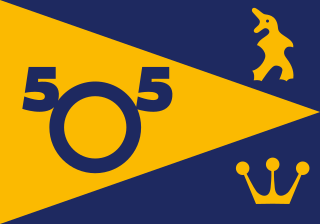5O5_(dinghy)
505 (dinghy)
International racing sailing class
The International 505 is a One-Design high-performance two-person monohull planing sailing dinghy, with spinnaker, utilising a trapeze for the crew.
This article needs additional citations for verification. (September 2020) |
 International 505 Logo | |
 | |
| Development | |
|---|---|
| Designer | John Westell |
| Year | 1954 |
| Name | International 505 |
| Boat | |
| Crew | 2 |
| Draft | 1.45 m (4 ft 9 in) |
| Trapeze | 1 |
| Hull | |
| Type | Monohull |
| Construction | unrestricted |
| Hull weight | 127.4 kg (281 lb) |
| LOA | 5.05 m (16.6 ft) |
| LOH | 5.05 m (16.6 ft) |
| Beam | 1.88 m (6 ft 2 in) |
| Rig | |
| Rig type | Bermuda Sloop |
| Mast length | 6.9 m (23 ft) |
| Sails | |
| Mainsail area | 12.3 m2 (132 sq ft) |
| Jib/genoa area | 4.94 m2 (53.2 sq ft) |
| Spinnaker area | 27 m2 (290 sq ft) |
| Upwind sail area | 17.3 m2 (186 sq ft) |
| Downwind sail area | 44.3 m2 (477 sq ft) |
| Total sail area | 44.3 m2 (477 sq ft) |
| Racing | |
| D-PN | 79.8 |
| RYA PN | 902 |
| PHRF | 149.4 |
| Class is a member of World Sailing | |
← Coronet
| |

The origins of the class began in 1953 with the creation of the 18-foot 'Coronet' dinghy designed by John Westell. This sailboat competed in the International Yacht Racing Union (IYRU) selection trials at La Baule, France, in 1953 for a new two-person performance dinghy for the Olympics. Although the Coronet lost Olympic selection to the Flying Dutchman, in 1954 the Caneton Association of France asked Westell to modify his design to create for them a 5-metre performance dinghy that would be suitable to their needs. Westell settled on a measured length 5.05 m to allow for boat-building tolerances of the day, and the resulting craft became known as the 505.[citation needed]
The class achieved international status with the IYRU in 1955.[1]
As of 2022, about 9,250 505s had been built.[2]
There have been many builders over the 60-year history of the class. At present Rondar Raceboats is the most prolific builder, producing wet-layup hulls on a semi-production basis. Ovington Boats, which at one time built hulls for Rondar under contract, now build their own.[citation needed]
List of current 505 hull builders:[citation needed]
| Builder | Location | Description | Website |
|---|---|---|---|
| Rondar Raceboats | Hulls and complete boats | www.rondarraceboats.com | |
| Ovington Boats | Bare hulls only | www.ovingtonboats.com | |
| Parker 505 | Bare hulls and complete boats | ||
| Van Munster Boats | Bare hulls and complete boats | www.vanmunsterboats.com | |
| Duvoisin Nautique | Bare hulls only | http://duvoisinnautique.ch/en |
It is typical for sailors to purchase bare hulls, spars and foils, and then rig the boats themselves. The result is that there is a wide variety of setups, with some notable regional preferences. For example, US boats traditionally have end-boom sheeting while German boats have mid-boom. This has led to the establishment of several rigging businesses, led by successful 505 sailors, that have developed standard rigging setups and sell complete boats based on bare hulls sourced from builders. These include Holger Jess with SegelsportJESS in Kiel, GER and Ian Pinnell of Pinnell & Bax in Northampton, GBR. Having standard setups with published tuning settings helps non-professional sailors become competitive more quickly. Similarly with sails. There is a handful of sailmakers that dominate the 505 class: Pinnell & Bax[3] in the UK, Bojsen-Møller[4] in Europe, Glaser[5] and North in the US and Narval in Poland.[citation needed]
The hulls of early 505s were built in cold-molded marine plywood, new hulls are now built using composite molding: glass fibre and/or carbon fibre mats and vinylester or epoxy resin using either a wet layup technique or using heat-cured prepreg sheets. Hulls are usually cored with foam, balsa or Nomex to increase stiffness and durability, spars traditionally were manufactured from aluminium alloy, later rule changes have permitted the use of carbon fibre for boom and spinnaker pole.[citation needed]
The hull shape and sail plan are tightly controlled, while the spars, foils and rigging are more open which allows the boat's rig and controls to be set up to the preferences of the crew, rather than dictated by the class rules.[citation needed]
The 505 is a large boat by dinghy standards, with a powerful sailplan, especially with the adoption in October 2001 of a larger spinnaker.[6] The 505 will plane upwind in wind speeds of around 10 knots or more.[citation needed]
World Championships
The International 505 Class Association organises an annual world championships which typically take place in Europe every other year and then elsewhere in the world on the alternating years. Some of the most famous names in sailing have competed at these championships and a lucky few have made the podium list below.
- "International 505". Outer Harbour Centreboard Club. Archived from the original on July 30, 2013. Retrieved July 20, 2013.
- "505 Sails at P&B". P&B. Retrieved 12 January 2022.
- "505-Sejl". Bojsen-Møller Sails. Retrieved 12 January 2022.
- "505 Sails". Glaser Sails. Retrieved 12 January 2022.
- "Summary of Rule Changes". www.int505.org. International 505. Archived from the original on 2018-06-12. Retrieved 2018-06-05.
- Official class website
- Official US class magazine website
- review
- Sandgate Yacht Club 505 Sailing
- ISAF 505 Microsite Website
- Rondar Raceboats, UK 505 builder
- JESS Segelsport, German 505 supplier/rigger, uses Rondar hulls
- Pinnell & Bax, UK 505 supplier/rigger, uses Rondar hulls
- Van Munster Boats, Australian 505 builder
- Binks Marine (Sandy Higgins), Australian 505 builder/rigger